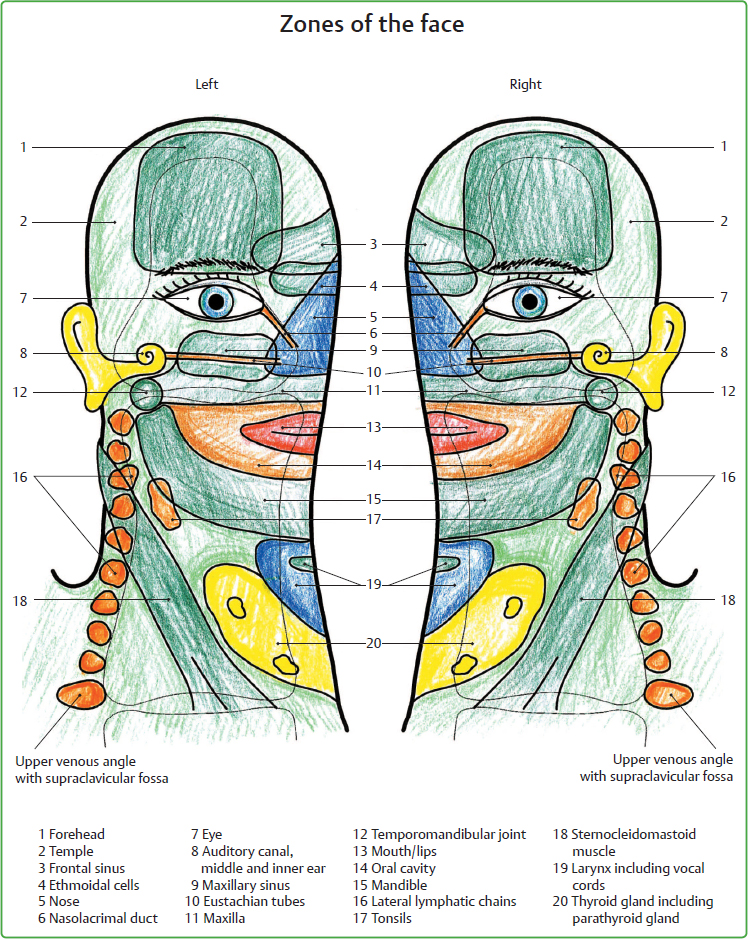28 Zones of the Face and Neck A person’s individuality is reflected particularly clearly in their face. Furthermore, facial diagnosis and pathophysiognomy provide detailed information. But the functional relationships between the individual face–neck zones and the whole organism can also be put to therapeutic use. They can be explained via various routes: • Nervous system • Development history • Meridians • Similarities in shape • Empirical experiences and observations Interrelationships are always involved: for example, a disease of the kidneys may affect the eyes while an eye disease may also affect the function of the kidneys. The respective facial zones are shown in Fig. 28.1. 1. Interrelationships between the eyes and: • Pancreas: Deterioration of the retina is a known long-term effect in diabetics. • Thyroid gland: If the thyroid gland is hyperactive, an exophthalmus (significant protrusion of the eyeball) may develop. • Kidneys: Both the eyes and the kidneys are paired organs and are both found in the same FitzGerald longitudinal zones. Both are involved in the transport of fluids (“solutions”). • Liver and gall bladder: Jaundice (transfer of bile components into the blood and into other body tissue) can be identified earliest in the sclera as a result of the white background of the conjunctiva. • Neck: Muscular tensions are relatively common in severely visually impaired individuals. With whiplash injuries in the region of the cervical spine, the eyes are also adversely affected. Neurophysiological: when tired, the eyelids close and the person “nods off.” • Stomach: The eyes “eat too,” that is, the secretion of saliva and gastric juices are coordinated in their reactions. The stomach meridian supplies the eyes, among other things, and ends in the zones of the eyes on the feet. • Inner ear and eyes jointly enable the coordination of movement (balance). Both develop from the same germ layer (ectoderm). 2. Interrelationships between eyebrows and bladder meridian: Its first point is located medially on both eyebrows. In its course to the little toes, it supplies, among other areas, the back muscles, kidneys, bladder, organs of the lesser pelvis, and the dorsal regions of the legs with its energy. 3. Interrelationships between the mouth and nasopharyngeal space and: • Bladder–genital area: The mucous membrane develops from the same germ layer respectively (entoderm). • Abdominal organs: Changes in the mucous membrane in the genital area (e.g., in pregnancy) are accompanied by physiological and pathological changes in the mouth and nasopharynx. • Metabolic system: Thrush in the oral cavity and herpes on the lips can arise as a result of bacterial disturbance in the intestine. 4. Interrelationships between the lips and: • Sphincters: Infants with teething problems are sore around the anus. Hurried drinking with pyloric spasm, etc. • Cervix: The tonus of the lips and cervix is coordinated—frequent confirmation as a result of observations by midwives. • Digestive organs: Dry, very wrinkled and chapped lips, rhagades, and herpes labialis often occur with gastrointestinal problems. 5. Interrelationships between vocal cords and genitals: • Voice and mood changes are associated with pregnancy, the monthly cycle, puberty (“breaking of the voice”), and the menopause. Famous singers are allowed to rest their voice during menstruation.
28.1 General Information
28.2 The Relationships in Detail
Musculoskeletal Key
Fastest Musculoskeletal Insight Engine








